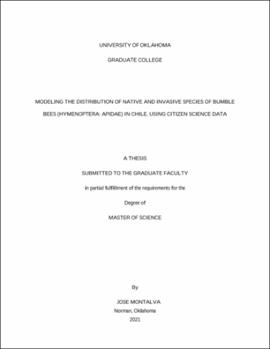| dc.contributor.advisor | Hoagland, Bruce | |
| dc.contributor.author | Montalva, Jose | |
| dc.date.accessioned | 2021-08-27T14:03:32Z | |
| dc.date.available | 2021-08-27T14:03:32Z | |
| dc.date.issued | 2021 | |
| dc.identifier.uri | https://hdl.handle.net/11244/330736 | |
| dc.description.abstract | There are around 260 species of bumble bees (Bombus) globally, many of them providing important pollination services. In fact, some species are bred and sold commercially to assure the successful pollination of crops. Bombus terrestris and B. impatiens are two species that are bred commercially. Since the 1980's some of these species have been imported to different countries worldwide, and these movements have created ecological problems, including (1) competition for resources with native pollinators, (2) importation of new diseases to the new environments, (3) hybridization with congeners, (4) disruption of the pollination of native plants, and (5) facilitation of invasion by introduced plants.
In this thesis, the utility and efficacy of citizen science data is analyzed and compared to the traditional use of distributional (museum data) records in Chile (chapter 2). Those data were then used to model the distribution of native and introduced bumble bees in Chile (chapter 3). Data provided by citizen scientists has become an important resource for conservation biologists. Between 2014-2020, Salvemos Nuestro Abejorro obtained over 4000 bumble bee records from citizen scientists in Chile. These data were significantly greater in number than museum data records for the introduced species. Thus, citizen science reports can have a broader impact on tracking the distribution of introduced species. In Chapter 3 we conducted multivariate bioclimatic niche analyses to evaluate the niche overlap of Bombus terrestris, Bombus ruderatus, and Bombus dahlbomii. The models indicated significant niche overlap between the invasive bumble bee species and the native species. B. terrestris had a high extent of suitable range in South America, meaning further invasion in the region is highly possible. Also, the models indicate that the distribution of B. dahlbomii will decrease due to future climate scenarios. Therefore, this comprehensive review and analysis of the consequences of these pollinator invasions on South America is both timely and necessary. | en_US |
| dc.language | en | en_US |
| dc.subject | species distribution models | en_US |
| dc.subject | invasion biology | |
| dc.subject | conservation biology | |
| dc.subject | Citizen science | |
| dc.title | Modeling the distribution of native and invasive species of bumble bees (Hymenoptera: apidae) in Chile, using citizen science data | en_US |
| dc.contributor.committeeMember | Neeson, Thomas | |
| dc.contributor.committeeMember | Silva, Daniel | |
| dc.contributor.committeeMember | Hoagland, Bruce | |
| dc.date.manuscript | 2021-08-26 | |
| dc.thesis.degree | Master of Science | en_US |
| ou.group | College of Atmospheric and Geographic Sciences::Department of Geography and Environmental Sustainability | en_US |
| shareok.orcid | https://orcid.org/0000-0003-1721-6425 | en_US |
